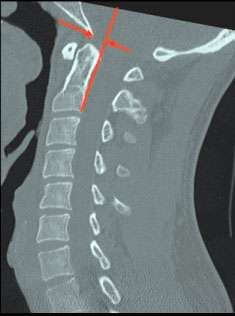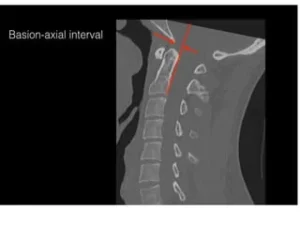Basion-axial Interval (BAI)
What part of my body can the basion-axial interval (BAI) be found?
Generally speaking, Basion-axial interval (BAI) is a measurement radiologists can use to detect atlanto-occipital dissociation (where the head and neck become unstable).
The basion-atlas interval (BAI) is the distance between two points in your neck: the basion and the posterior arch of the atlas. Doctors use this measurement to check for injuries in the neck area. The basion is a point at the base of your skull, and the atlas is the first cervical vertebra in your neck.
Basion-axial Interval (BAI) helps to rule out horizontal atlanto-occipital instability.
How do Radiologists measure BAI?
Radiographical investigations such as X-rays and CT scans are used to measure this. These same tests are used when there is suspicion of any abnormality of the BAI (FIGURE 1).

It is the distance (in mm) between the basion and the superior extension of the posterior cortical margin of the body of the axis in the median (midsagittal) plane.
What is considered normal BAI for a person?
In adults, a normal BAI measurement is less than 12 mm when taken using an X-ray.

Another source states, Basion-axial interval (BAI) is considered abnormal when there is anterior displacement of 12 mm or more or posterior displacement of 4 mm or more between the basion and posterior C2 line. Reference
What can disturb the regular basion-dens interval?
Any condition causing atlanto-occipital dissociation can also affect the BAI. Atlanto-occipital dissociation injuries are serious injuries that can happen at the joint between the base of the skull and the first vertebra in the neck. These injuries can cause the joint to become unstable because they damage the ligaments that hold it together. This instability can affect the BAI measurement.
What are common symptoms of people with an abnormal BAI?
If you indeed have an abnormality of the BAI, then you could experience the following symptoms:
Motor or sensory neurological deficiencies: This can include weakness or loss of sensation in the arms or legs.
Cranial nerve deficiencies: This can affect vision, hearing, and facial movements.
Cervical-medullary syndrome: This can cause various symptoms, such as difficulty swallowing, hoarseness, and weakness in the arms or legs.
Diagnostic Imaging – XRay, CBCT/CT & MRI
Standard anteroposterior, lateral and open-mouth odontoid views as well as flexion and extension are the routine preliminary screening radiographs (XRays).
For many years CT has remained the standard radiologic technique for fractures and dislocations in the craniocervical region. CT with 1.5-mm cuts and reformatting in both the coronal and sagittal planes provides detailed visualization of the bony relationships and congruency of the atlanto-occipital joints.
A CT scan of the head may demonstrate cranial– cervical junction subarachnoid hemorrhage or avulsion fractures of the occipital condyles, both of which are associated with atlanto-occipital dissociation, and raises the suspicion of severe craniocervical ligamentous injury. Reference.
Note: While we are still doing research on this topic, some upper cervical chiropractors utilize CBCT imaging in-office which may be a more easily accessible option for some patients. CBCTs apparently have nearly the same radiation as XRays and about 10% the radiation as CT Scans – we’ll be researching this more and will post when we find out more science based information on this topic.
MRI is emerging as a valuable (in conjunction with CBCT/CT) in the diagnosis of atlanto-occipital trauma. MRI is unsurpassed in evaluating ligamentous and neural structures. New sequencing techniques have allowed better visualization of bone, vascular structures and acute hemorrhage. These numerous advantages, along with the need to obtain a timely diagnosis, strongly support MRI as the standard for the evaluation of trauma to the occipito-cervical region. Reference
Last but not least, when investigating craniocervical junction abnormalities, it’s best to seek dynamic imaging.
Dynamic Imaging and Translational BAI
The measurement Translational BAI (T-BAI), based on research, are only noted by 2 articles and therefore not widely recognized nor practiced. Reference 1. Reference 2.
Henderson “When possible, the Harris measurement/BAI is made from the MRI or CT in both flexion and extension to assess translation (sliding movement) between flexion and extension. Horizontal Harris Measurement (HHM): a measurement of > 12 mm represents craniocervical instability. If the HHM changes by > 2 mm between flexion and extension, then craniocervical instability is inferred”
Japan & Great Britain ” …we investigated the association between spinal cord compression… abnormal values: BAI<-12mm or >5mm in neutral position… These data suggest that occipito-atlantal and atlantoaxial instability measured with ADI, SAC, and BAI are significantly associated with spinal cord compression in MRI… As a result, dynamic compression should be evaluated using flexion-extension MR imaging. In addition, the previously reported abnormal ADI and SAC can be reasonably applied for screening in the Japanese population.”
List BAI legitimate measurement?
Canadian Neurosurgeons: “Based on our systematic review, we recommend that the CXA, Harris measurement (BDI & BAI), Grabb-Mapstone-Oakes measurement, and the angular displacement of C1 to C2 be used to evaluate suspected CCI in EDS patients. Surgical fixation of suspected CCI should only be performed in cases with clear radiographic presence of instability and concordant symptoms/signs. Consensus-based guidelines and care pathways are required.” (Canada) Reference
Is research still active for this condition?
Because the BAI is due mainly to atlanta-occipital dissociation, which can include dislocation and subluxation, multiple research papers have been conducted on the subject. However, most of these are case studies and are regarded as third place regarding the level of evidence.
REFERENCES
- Hacking C. Basion-axial interval | Radiology Reference Article | Radiopaedia.org [Internet]. Radiopaedia. [cited 2023 Apr 30]. Available from: https://radiopaedia.org/articles/basion-axial-interval-1
- Hosalkar HS, Cain EL, Horn D, Chin KR, Dormans JP, Drummond DS. Traumatic atlanto-occipital dislocation in children. J Bone Joint Surg Am. 2005 Nov;87(11):2480–8.
- Vachata P, Bolcha M, Lodin J, Sameš M. Atlanto-occipital dissociation. Rozhl V Chir Mesicnik Ceskoslovenske Chir Spolecnosti. 2020;99(1):22–8.
- Atlanto-axial instability (AAI): What you need to know [Internet]. Massachusetts General Hospital. [cited 2023 Apr 30]. Available from: https://www.massgeneral.org/children/down-syndrome/atlantoaxial-instability-aai
- Holy M, Szigethy L, Joelson A, Olerud C. A Novel Treatment of Pediatric Atlanto-Occipital Dislocation with Nonfusion Using Muscle-Preserving Temporary Internal Fixation of C0-C2: Case Series and Technical Note. Journal of Neurological Surgery Reports. 2023 Jan;84(01):e11-6.
- Lepard JR, Reed LA, Theiss SM, Rajaram SR. Unilateral atlantooccipital injury: A case series and detailed radiographic description. Journal of Craniovertebral Junction and Spine. 2022 Jul 1;13(3):344.
- Wathen C, Ghenbot Y, Chauhan D, Schuster J, Petrov D. Management of Traumatic Atlantooccipital Dissociation at a Level 1 Trauma Center: A Retrospective Case Series. World Neurosurgery. 2023 Feb 1;170:e264-70.
- García-Pérez D, Panero I, Lagares A, Gómez PA, Alén JF, Paredes I. atlanto-occipital dislocation with concomitant severe traumatic brain injury: A retrospective study at a level 1 trauma centre. Neurocirugía (English Edition). 2023 Jan 1;34(1):12-21.
-
Craniocervical Instability in Ehlers-Danlos Syndrome-A Systematic Review of Diagnostic and Surgical Treatment Criteria.
- The Association Between Radiographic and MRI Cervical Spine Parameters in Patients With Down Syndrome.

